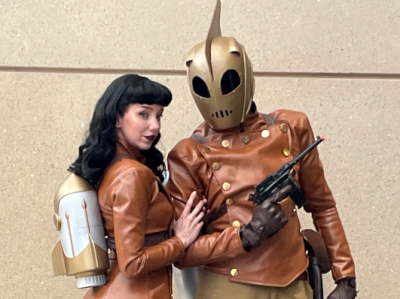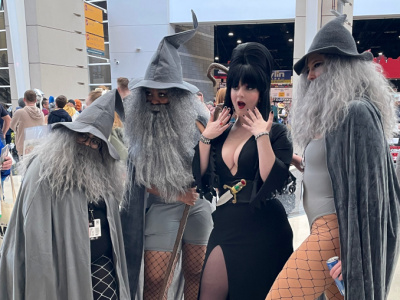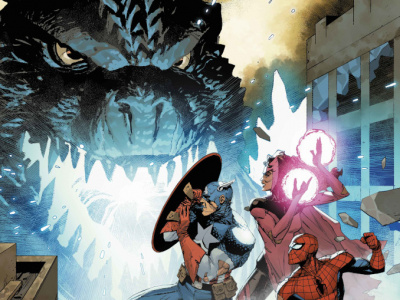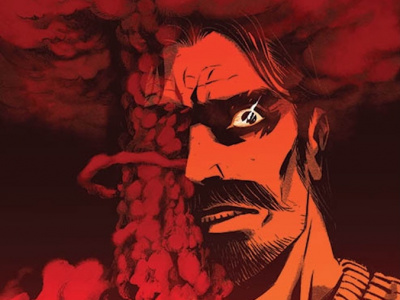
We recently chatted with DC Comics President and Publisher Paul Levitz to catch up on topics of interest. In this first part of our two-part interview, we talk about the state of the comic and bookstore channels of the comic market, the manga explosion, and DC's recent run of sell-outs.
One of the things we've covered in the past in these conversations that I'd like to cover today is the state of the market. To break it down by channel, what do you see in the direct market this year in terms of a market trend?
It feels like the market is going up in terms of the enthusiasm level of people coming in the stores and their ability to get excited about different titles again, and that's probably more than this year; but maybe a year, year and a half back that tide seems to have changed a bit. It's not completely clear to me how much of that is people giving up on things they don't care about, but getting much more excited about things they do; but the ceiling seems to be lifting a bit, which we haven't seen for a while.
That sounds like the floor may be also dropping?
Not for us, so I can't read that as well. We tend to have the advantage of usually sitting at least on the second or third story of the building for our weakest stuff because there are so many people that are dedicated to the brands.
There's certainly some pain out there, but I don't know whether that pain is because the consumers are supporting the weaker stuff less or simply that the cumulative exhaustion of trying to climb those first couple of stories is catching up with people.
Overall you said the ceiling is rising on a per title basis. Do you have any feel for the overall dollar size of the market in the direct channel?
I haven't spent a lot of time with those numbers this year. My gut is it's up, on two bases. One, looking at the balance of our share versus our dollar sales versus what's going on with our backlist business, we seem to be up and our share doesn't seem to be tremendously up, so that would say that the overall market must be growing in some fashion. The other part of it is that there's some mixture of distribution serving the [comic] shops on things like backlist where they're also bringing in product from places other than Diamond. And in a year like this where that kind of product is becoming more and more important to them, I suspect that would show some growth that we are probably mistakenly attributing to the book market. I don't know if you've got any sense of where the real border is drawn between the two; I'm not sure anybody can figure it out.
There is channel leak, and the size is very difficult to determine. How about the number of comic stores? Is that pretty stable?
Last I heard. Haven't heard of any high profile disappearances.
What's the bookstore market like this year?
Lovely growth on our end, and we've certainly lost share with what's gone on with manga, which has grown explosively. Again, that's always been a market where it's very hard to define what you're looking for a market share of and who your competitors are at the border of it. But you look at companies like Tokyopop and look what's going on there, you have to say that there's some phenomenal growth going on in that business.
How about the number of pockets in bookstores? Last year when we talked that number had been going up quite a bit. How about this year--has that continued, or has it flattened?
Well what we saw last year that was easy to quantify was the number of bookstores that had graphic novel sections. That's much easier to measure than how many feet you've got of running space in the stores that carry the products. So when a new store comes in and says 'great, ship me three each of everything you've got that I should care about,' [it's easier to quantify]. When you get a couple more square feet, it tends to leak in more slowly. My sense is we've gotten increased commitments; a lot of that's gone to manga. So I'm not sure if the American comic graphic novels have net gained a lot of space last year, but it's at least held its own and maybe it's picked up a bit.
Again I think the interesting thing is what's happened with the ceiling, when you look at, for us, something like League of Extraordinary Gentlemen. There I don't think it's a big issue of channel leakage. I don't know what our number was anymore, but we probably sold two or three times as many trade paperbacks of the first League series in bookstores as we anticipated without the movie having any really strong results to be driving it. We kept hearing anecdotal stories of people saying 'here, try the book, the book's more fun than the movie.' And that kind of hand selling is unusual. I think we're on the seventh printing of it, or something like that.
What about the market for your figures and statues?
We had a very nice year this year. I'm told that's becoming a tougher category in general, but we had the advantage this year that it was the first year that we were able to more fully integrate the Superman and Batman properties into the line as a consequence of the shift in deal when we shifted over to Mattel as our master toy licensee. So that fueled a very nice year for us; we're up ten/twelve percent, we're estimating for the year.
In a down market.
I think it's a down market. I mean obviously I don't get hard numbers for that, but what I hear is that it's a tougher one. And without any giant movies or TV shows supporting that kind of product.
DC has had a run of sellouts of periodical titles, of floppies, recently. Editorially what has DC done differently in the last year versus the year before to make the books sell better?
A couple of things happened. One, we reorganized the DC Universe group, I guess it would be about eight or nine months ago now. Dan Didio moved in there to become more involved on a day to day basis running that editorial group hands on. Mike Carlin moved over to take over the Justice League titles and get back to the fun of actually editing, which he was anxious to do. Dan is a very commercially focused editor, and coming at it as fresh blood, not having been in a role like that before, went in very competitively; tried to identify what he felt would be saleable and exciting; what would have been exciting to him as a reader. Some of his choices made perfect sense to some of us working around him, some of them made no sense, and his batting average has been pretty good. Things like Outsiders and Teen Titans which were not instantaneously obvious choices for major projects to support, he was a big supporter of. He helped organize how we launched; what teams we put on them; and I think those have both been conspicuous successes.
There's also been an enormous tailwind pulling us along from the Jeff Loeb/Jim Lee Batman. One of the things I think is characteristic of the comic book business in general is that good work begets more good work. When you, on the one hand, demonstrate that good work can succeed you encourage more writers and artists to take more chances or do better stuff. Or, do it for you rather than for your competitors. And also, I think on a very primal rivalry basis, when there's cool stuff being done, writers and artists work hard to outdo it. And I think Jeff and Jim's quality of work on Batman and the commercial success of it provoked both of those reactions.
For Part 2 of this interview, in which we discuss the sales of Sandman, Endless Nights, DC's movies and TV shows, kids comics, artist exclusives, and a possible foray into manga, see 'Interview with DC's Paul Levitz, Part 2.'







